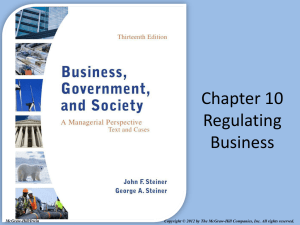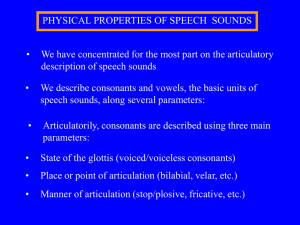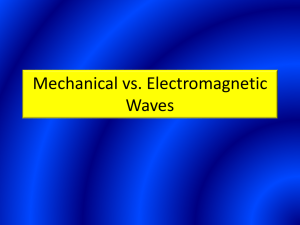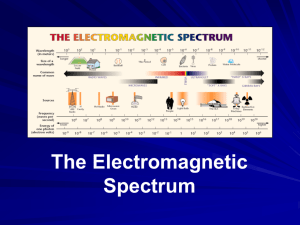Heat, Light, Sound
advertisement
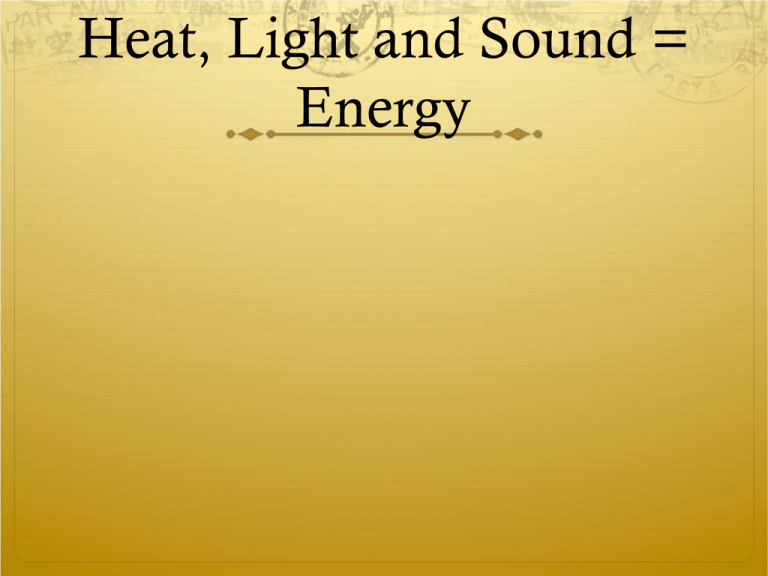
Heat, Light and Sound = Energy First let’s talk about energy. Energy is when something has the ability to do work. Examples: fire can make heat energy, the sun can make light energy and a trumpet can make sound energy. Forms of energy waves Many forms of energy travel in waves. Mechanical waves, like sound waves, seismic waves and water waves, need a medium to travel through. A medium is anything in which an energy wave can flow through. Electromagnetic waves like visible light and radio waves can travel through nothing as well as many different mediums. Waves Energy often travels in waves and the strength of the energy depends on how high the wave is or how close the waves are together. Transverse waves move at a right angle to the energy flow. The highest point of a transverse waves is called a crest and the lowest point is called a trough. Wavelength Wavelength is the distance between two crests of a wave or two troughs. Amplitude Amplitude is the measure of how much energy a wave is carrying. The greater the amplitude, the greater the energy. Frequency The frequency is the number of waves that pass by a set point in a second. Frequency is measured in hertz (waves per second). Frequency is related to wavelength. The larger the wavelength the lower the frequency. The smaller the wave length the higher the frequency. The higher the frequency the greater the energy. What do you think? What has more energy? A wave with a high amplitude and a short wave length. Or a wave with a long wavelength and a short amplitude. The wave with a high amplitude and a short wavelength has a lot more energy. La Energía La energía : la capacidad de hacer un trabajo. La energía viaja como las ondas. Las Ondas Las ondas : son cadenas de moléculas con vibración. Las ondas se mueven arriba y abajo. La Frecuencia La frecuencia: es un tipo de medición que cuenta el número de ondas que pasan por un punto dado en un segundo. Cuando la frecuencia sea alta hay mas energía. Cuando la frecuencia sea baja hay menos energía. La longitud de onda La longitud de onda : medida que describe lo larga que es una onda. La longitud de onda es pequeña. La longitud de onda es grande. El medio El medio: una sustancia que puede transmitir una onda. El aire es un medio que puede transmitir ondas de luz. La luz viaja rápidamente. Viajar yo viajo tú viajas él viaja nosotros viajamos vosotros viajáis ellos viajan Las ondas de sonido viajan hasta nuestros oidos. Heat Heat is the total amount of energy an object has because of its moving molecules. Heat is capable of being transmitted through solids and liquids by conduction, through fluid media by convection, and through empty space by radiation. Temperature vs. Heat Heat is the total amount of energy in a system Temperature is a measure of the average kinetic energy of each atom in that system. Example: Both glasses have the same temperature (molecules are moving at same speed) but a different heat because the glass with more water has more molecules moving around to transfer the energy. Consider each glass to be a system Same temperature Higher heat Lower heat Conduction Conductor- remember a conductor is an object that allows energy (like heat and electricity) to travel through it easily. Conduction is the transfer of heat between two objects because they are touching each other. Examples: Placing a pan on a burner Touching a curling iron with your hand Types of Conductors Good conductors are objects that energy (like heat) flows through easily. Metal is a great conductor, that is why we use it for pans. Poor conductors are objects that energy does not travel well through. We call these insulators. Wood, cloth, plastic and rubber are insulators because they do not allow energy to pass through them easily. That is why they are used for things like pot holders and handles, so that you do not burn yourself. Convection Convection is the transfer of heat through liquids and gases as molecules circulate in currents. Convection represents the transfer of heat by circulation or movement of the hot particles to cooler areas. Convection through liquids. Convection through liquids (water) * A pan full of water heats up on a stove. First the water on the bottom heats up. The hot water then is pushed out of the way by the cooler water on top (because cool water sinks) and this water warms up. This will go on until all of the water is the same temperature. If the water continues to heat up it will evaporate. This circulation of heat is called convection. Convection through gases. Convection through gas (air) * As the hot ground warms the cool air above it, the air starts to rise. Warm air always rises because it is less dense. Cool air always sinks because it is more dense. As the air warms up, cooler air sinks and pushes the warm air up and out of the way. This movement of heat energy through the air is called convection. Radiation Radiation is the transfer of energy by electromagnetic waves. Radiation can travel through space (nothing). The sun’s radiant energy (radiation) travels through space to Earth and warms us up. Examples The sun warming your face. Heat from a light bulb (without touching it). Absorption Absorption – Taking in or swallowing up energy. Examples When you touch a hot object your hand will absorb the energy and your hand will become warmer. (heat is energy! Solar panels absorb heat energy from the sun and turn it into usable power. Earth absorbs the sun’s radiant energy and that heat warms Earth’s cooler air. That is how Earth is warm enough to live on. El calor El calor: un tipo de energía contenida dentro de un objeto a causa del movimiento de sus moléculas. Los objetos calientes tienen moléculas que se mueven rápidamente. El conductor El conductor: es un material en que energía puede moverse fácilmente. El aislador Un aislador es un material en que la corriente de energía no puede pasar fácilmente, como el plástico. La conducción La conducción: El translado de calor entre sustancias por contacto directo. La convección La convección: El translado de calor por los líquidos y los gases cuando los moléculas se circulan en corrientes. La radiación La radiación: El translado de calor por espacio en la forma de ondas. La absorción La absorción: El proceso de colectar energía. Light Light is a form of energy that zooms around in both waves and particles (photons). There is both artificial light and natural light. Artificial light Light bulbs Candle and other burning objects Natural Light Sun Chemical reactions in animals Forms of radiant energy Radiant energy is a form of energy transferred by radiation. This energy can pass through space and it described as a spectrum. The different forms of radiant energy are: Radio, TV, Microwave, Infra Red, Visible Light, Ultra Violet Light, X-Ray, Gamma A spectrum is a series of energy bands. The colors red, orange, yellow, green, blue, indigo, and violet, arranged in order of their wavelengths and seen when white light passes through a prism. (Roy G. Biv) Photons Light travels in two ways: through photons and through waves. Photons are tiny, invisible, packets of light. Photons have different levels of energy. The shorter the wavelength the higher the energy. Red light has the longest wavelength and the least amount of energy. Light moves in waves also. Waves are measured by their frequency, or how closely they travel together. High frequency waves travel closer together and have a higher energy. Low frequency waves travel farther apart and have a lower energy. Wavelength is the distance between the peaks of two different waves. Waves Refraction Normally light travels in a straight path, but when it hits an object of a different density the light will bend this is called refraction. Refraction – When light bends as it travels from one medium to another. A medium is any substance through which a wave is transmitted (sent through). Light does not need a medium in order to travel, it can travel through space where there are not air particles to carry it. This is useful otherwise we would not be able to use the sun’s energy. Hey that’s me! Reflection Our ability to see depends on the reflection of light. Reflection is when rays of light or heat are reflected, or bounced off other objects. If light reflects off a smooth surface (like a mirror) it will bounce off at the same angle. This is how we are able to see our selves perfectly through a flat mirror. Hit Me!! Light hits objects at certain angles. Angle of incidence – The angle at which light strikes a surface. Angle of reflection – The angle at which light bounces off a surface Mathresources.com sol.sci.uop.edu Color in light Visible light is made up of many different colors. White light is the combination of all colors. Blackness is the absence of all light. We see colors when a particular color is reflected off the surface of an object. The other colors are absorbed. Colored light can be combined to create different colors. Prisms We can see the different colors of light when white light enters a prism and refracts (bends). Remember a prism is a 3D shape with two bases that are the same shape. The prism refracts the light and separates the colors. Each color of light bends slightly differently than the others. A rainbow occurs because raindrops act as prisms. The sunlight enters the raindrop and is refracted, creating a rainbow. La luz La luz: es una forma de energía que se mueve por las ondas y los fotones. La refracción La refracción: una desviación de las ondas luminosas cuando pasan por materiales diferentes. La reflexión La reflexión: un cambio de dirección de las ondas luminosas cuando rebotan de un objeto. La prisma La prisma: un trozo de vidrio que divide los colores diferentes de luz. El espectro El espectro: Los colores: rojo, anaranjado, amarillo, verde, azul, indigo y violeta se arreglan según sus longitudes de onda. ver yo veo tú ves usted/él/ella ve nosotros/as vemos vosotros/as véis ustedes/ellos/ellas ven Sound Sound, like heat and light, is a form of energy. Sound is heard because it makes air particles vibrate (rapid back and forth movement). Sound travels through air as sound waves. Sound waves travel in all directions from the source of the wave. Sound waves are different from electromagnetic waves, because sound waves need a medium to pass through. If sound waves don’t have something to pass through, they don’t go anywhere. Sound can also travel through water, metal and other things. Pitch Pitch is how high or low a sounds is. Pitch depends on how close together the waves are in a sound wave or high the frequency is. The closer the waves are the higher the pitch. Waves with a lower frequency, or waves that are farther apart, have a lower pitch. Loudness or Volume The loudness of a sound is called volume. How loud a sound is depends upon how many particles are moved by the sound wave, or how high the amplitude of a wave is. If a sound wave moves a lot of particles, the sound is loud. If a sound wave moves a small amount of particles, the sound is soft. A sound wave with a loud sound has a high amplitude and visa versa. Decibels The loudness of a sound is measured in decibels. The higher the decibel the louder the sound is. What object has the loudest sound? Sound travels Sound waves don’t only travel through air (gas). Sounds travels farther through solids and liquids because the particles in solids and liquids are closer together than they are in gases. What happens to sound waves? The farther away you are from a sound, the harder it is to hear. This is because as sound travels it loses energy. It will eventually run out of energy and the sound can no longer be heard. Loud sounds have more energy and it takes them longer to lose their energy. El sonido El sonido: como el calor y la luz, el sonido en una forma de energía que viaja mediante ondas. Podemos oír sonidos con nuestros oídos. El sonido es ruidoso. El sonido es suave. La vibración La vibración es un movimiento rápido que se mueve hacia adelante y hacia atrás. La vibración es rápida. La vibración es lenta. La echada La echada: cómo alto o bajo una nota musical suena. Yo oigo la echada alta. María oye la echada baja. El volumen • El volumen es el nivel de intensidad de un sonido. • El volumen es mínimo. • El volumen el máximo. Oír yo oigo tú oyes usted/él/ella oye nosotros/as oímos vosotros/as oís ustedes/ellos/ellas oyen


